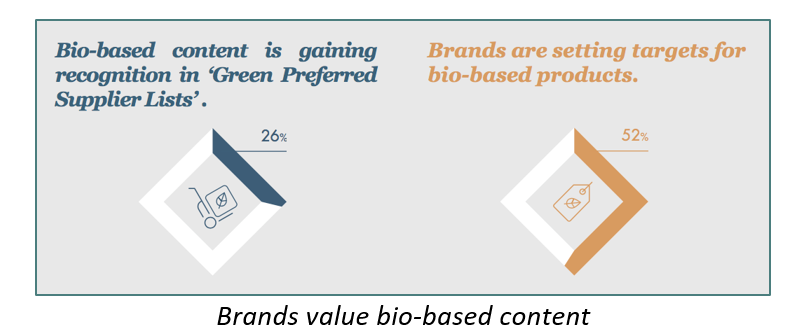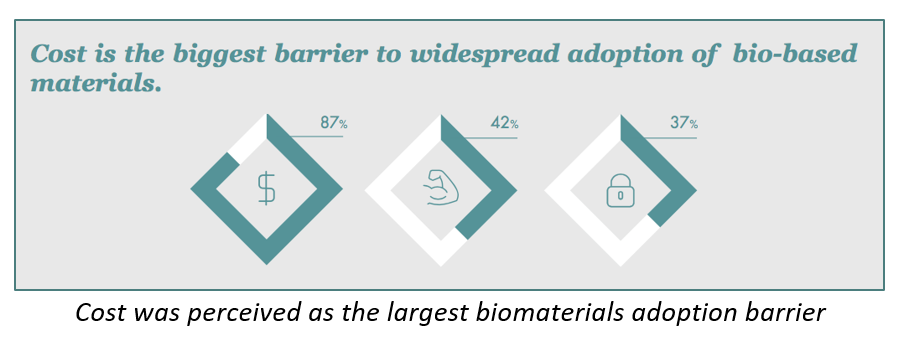Materials Science
#WhatBrandsWant reveals brands’ perspectives on biomaterials 5th March 2018
By Noémie Léonard, Junior Consultant at Sustainability Consult
Noémie Léonard, Junior Consultant at Sustainability Consult, presents results from #WhatBrandsWant, the company’s survey focus
Noémie Léonard, Junior Consultant at Sustainability Consult, presents results from #WhatBrandsWant, the company’s survey focused on brand perceptions of bio-based materials. Are brands ready to invest in bio-based solutions? What is helping and what is slowing down the industry?
We often hear the questions: how can we encourage brands to invest in renewable materials? How can biomaterials manufacturers make it easier for brands to engage?
We wanted to answer these questions, so we launched #WhatBrandsWhat – Sustainability Consult’s first ever stakeholder survey. The goal was to assess attitudes towards the bioeconomy, and highlight opportunities to help mainstream bio-based solutions. Over a six-month period, we gathered responses from over 40 brands across different sectors ranging from apparel, footwear & textiles, to food & beverages and personal care.
Consumers will boost sustainability
One clear trend stood out: consumers are the engine for change. Consumers’ interest in sustainability is influencing brands, who in turn pay attention to the bioeconomy. Advances in biomaterials have not previously been matched by demand – yet this is changing.

Most brands surveyed believe we will witness a moderate to strong growth in the sector by 2025. Besides consumer demand for environmentally-friendly products and packaging, this expected growth is mostly due to brands wanting to improve their public image. When brands use biomaterials, they are proud of it – 71% said they communicate externally about using them.
Stakeholder pressure to increase supply chains’ sustainability has significantly increased in recent years, especially for industries criticized for sustainability issues such as clothing, footwear and personal care. The survey found these sectors are more likely to have a ‘Green Preferred Supplier List’, which asks suppliers to adhere to certain sustainability criteria. Brands are increasingly willing to consider using bio-based materials in their supply chains.
A bright future for biomaterials
Overall, we found a range of other encouraging findings in #WhatBrandsWant. For example, even within brands not currently using biomaterials in manufacturing, two-thirds intend to incorporate them into future product lines, and half are conducting R&D on bio-based materials.
Another positive find was that half of the brands surveyed have set targets for sourcing bio-based materials. One quarter said bio-based content was one of the selection criteria when choosing a supplier based on sustainability performance.
Brands have many reasons to move towards biomaterials – consumers and stakeholders are pulling in this direction. Yet, there are also challenges which are preventing a quick adoption of renewable options.

Bioeconomy challenges remain
A range of barriers to biomaterials continue to affect the sector. A majority of respondents (87%) agreed that cost is the main barrier for adoption, followed by performance and availability. Some brands were also worried about recyclability of bio-based materials.
For our wider network of bioeconomy and sustainability experts, the lack of awareness about bio-based solutions is seen as the second most important barrier after cost. Biomaterials producers understand brands do not have all the information they need on certain aspects of bio-based alternatives, therefore more awareness-raising is needed.
Nevertheless, forward-thinking brands are investing strategically to bring sustainable, innovative products to market. If biomaterials producers engage with the entire supply chain to identify performance benefits, this could offset concerns around higher costs.
Communicating with brands and consumers
Brands in our survey felt knowledgeable and informed about bio-based materials. However, when evaluating whether to adopt bio-based materials 63% said they needed more information about pricing, 61% mentioned needing to know more about availability, and 57% wanted to find out more about performance.
It is important for manufacturers to provide tangible evidence on product advantages. This means it is essential for producers to communicate credibly about renewable products. It will be necessary for brands to also communicate openly on the type of biomass they use, and on their products’ end-uses for both food and industrial applications. Where possible, Life Cycle Assessment (LCA) and third-party certifications should be undertaken to promote responsible sourcing.
However, for general public communications, tools like LCAs are too complex. Product information should be simplified and communication focused on consumer benefits. To help brands communicate credibly and increase awareness of bio-based products, Sustainability Consult’s CEO Kathryn Sheridan developed her ‘five commandments for the bio revolution’1 which still influence our work today.
What will boost bio-based uptake?
Overall, #WhatBrandsWant reflects positively on the sector and growth is expected. Consumers are on board and stakeholders are pressuring brands for bringing more renewable options to market. However, some barriers remain and, if the benefits offered by biomaterials are not made clear, perception of high cost could continue to impact uptake.
If cost and lack of awareness are seen as crucial barriers, action needs to be taken. The market is ready, and brands need to be provided with the information they need to choose sustainable options. From the work we are doing with our bioeconomy clients, we can see that this is already happening. We believe that the future is bright for biomaterials.
Reference
1. Sheridan K. Spec Chem Magazine 2013;33:5.



